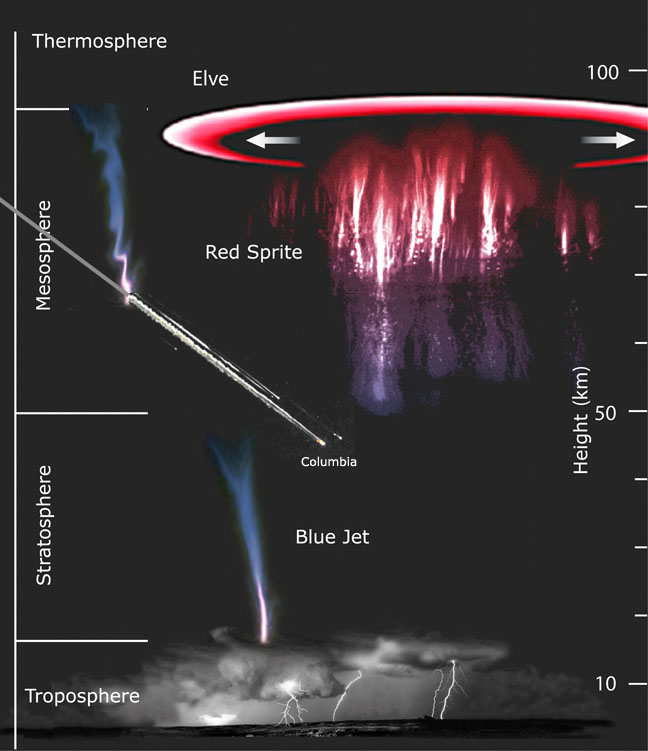|

Feb 23, 2005
from
Thunderbolts Website

The original photograph has been
withdrawn at the demand of the photographer (Andy
Robins).
The graphic here just shows the altitude of the disaster, along with
an electrical
interpretation of the withdrawn photograph.
It has now been more than two years
since the fiery destruction of the shuttle Columbia on February 1,
2003. The disaster killed all seven astronauts on board and dealt
one of the most severe blows ever to America’s space program.
But as astronauts now prepare to ride another shuttle into space,
few Americans are aware of the most critical issue raised by the
Columbia disaster. Did a super-bolt of lightning - called "megalightning"
- strike Columbia, causing the breakup of the craft?
Shocking evidence that this is so includes the image above, taken
from the TV program "Megalightning."
It shows a purplish
corkscrew trail of "something" merging with the ionized plasma
trail of Columbia early in its descent, while Columbia was still 63
kilometers above the earth. One might have expected this image to
catch the attention of media around the world. But before that could
happen, both the camera and the photograph were examined by NASA
scientists.
Most shocking was the explanation given by experts who examined the
photograph. They said that the luminous corkscrew trail was an
"artifact" caused by a camera wobble. The explanation left critics
aghast, since the Columbia trail in the photo is crisp with no
evidence of camera movement. Nor is any wobble evident in other
similar photographs taken at the time. The explanation relegates to
"coincidence" the fact that the Columbia trail brightens precisely
at its juncture with the corkscrew trail. This brightening is an
electrically predictable occurrence when two plasma
channels merge.
Proponents of the "Electric
Universe" have maintained for many years that ideology
within official science has limited the ability of working
scientists to look at pictures objectively, to see what would
otherwise be obvious. Popular doctrines say that Earth is a neutral
body in the neutral environment of the Sun. When lightning strikes,
its source must lie in the mysterious ability of clouds and
temperature gradients to "separate charge." A bolt of lightning in
the rarified atmosphere 63 kilometers above the earth is unthinkable
within this framework. Therefore, the alleged lightning strike on
Columbia could not have happened.
Alternative viewpoints do not suffer from these limitations. In
the Electric Universe, our Earth is an integral part of solar
system circuitry, fed by currents streaming along our arm of the
Milky Way. An electric field between Earth’s surface and the
ionosphere, separated by an insulating layer of atmosphere, is
responsible for thunderstorms.
In weather conditions favoring breakdown
of this insulation, electric currents leak through the atmospheric
layer (in the fashion of a "leaky capacitor"), creating the
electrical displays we see in thunderstorms. And this is why, far
above thunderstorms, meteorologists have discovered powerful
discharges called "red sprites" and "blue jets" reaching many
kilometers into the ionosphere. In fact, electrical interactions
associated with powerful thunderstorms have now been traced outward
to the Van Allen Belt.
Since the discharge of a sprite is diffused over a large area,
meteorologists have doubted that a sprite could damage aircraft. But
here is how Wallace Thornhill, a pioneer of
the Electric Universe hypothesis,
views the issue:
"The electromagnetic 'pinch' effect
will ensure that the energy of that sprite will be focused onto
any large electrical conductor that blunders into its domain –
as we see in the time-lapse photograph. The brightening of
Columbia’s trail where the lightning joined it is due to the
sudden release of energy in the more dense plasma of that trail.
It is that kind of energy that was released over a few square
centimeters of Columbia’s wing. Temperatures of tens of
thousands of degrees would have resulted. The Shuttle’s tiles
are designed to withstand 2900 C."
This is where Professor Edgar Bering,
a physicist at the University of Houston in Texas, comes in. He
heads a team from NASA's National Scientific Balloon Facility
to study
sprites by flying a high-altitude balloon above major
thunderstorms. His work, preceding the Columbia disaster, led to
some surprising conclusions about sprites. He found that the charge
released in sprites is not generated within the clouds, but lies in
the mesosphere above the thunderstorms. And the energy is far
greater than previously thought.
But according to Thornhill, all of the data will fall into place if
the charge in the mesosphere "comes from space via the ionosphere
above," not from charge separation within the clouds below. It will
then make sense that Bering found the current released in a sprite
to be around 12,000 amperes, rather than the 3,000 amperes predicted
by conventional models of cloud-generated charge.
It does not appear, however, that NASA scientists have
followed Bering’s discovery to its logical conclusion: "None of the
existing models will survive when people finally pay attention to
what our data actually says," Bering writes.
If the fate of Columbia was indeed the result of megalightning,
then scientific misperception has cost human lives. And it is now
placing other lives at risk as well.
Read more at:
Columbia downed by Megalightning
|

